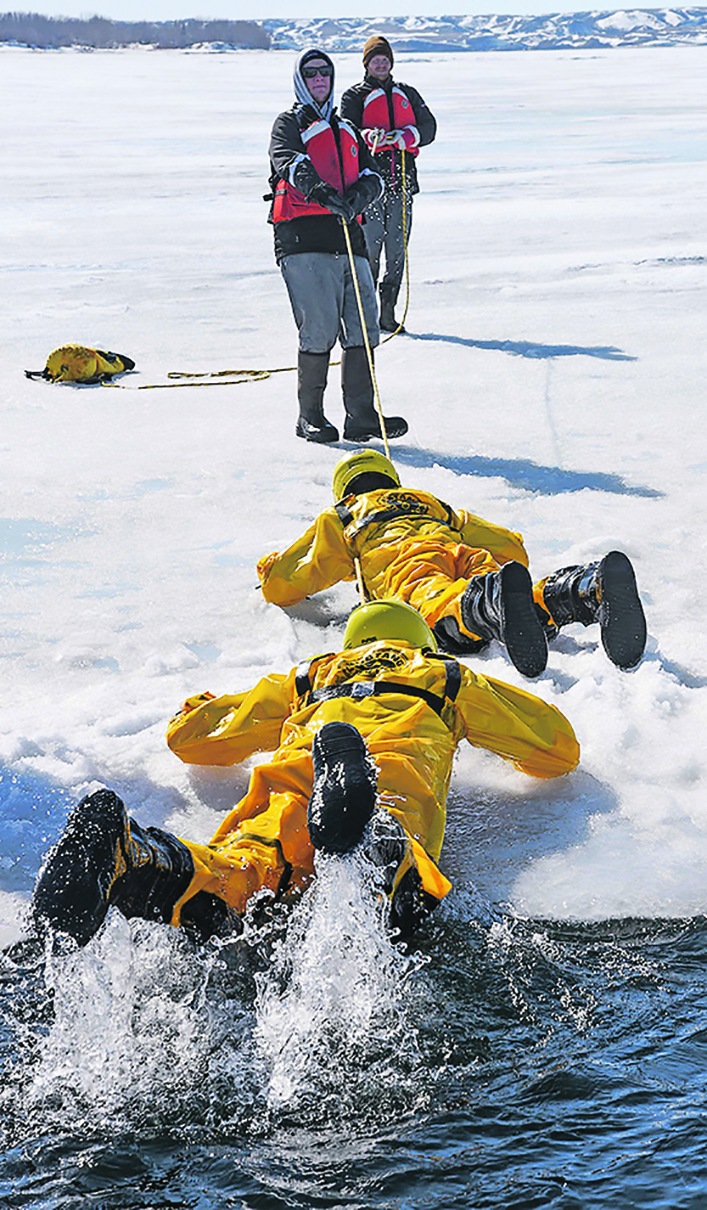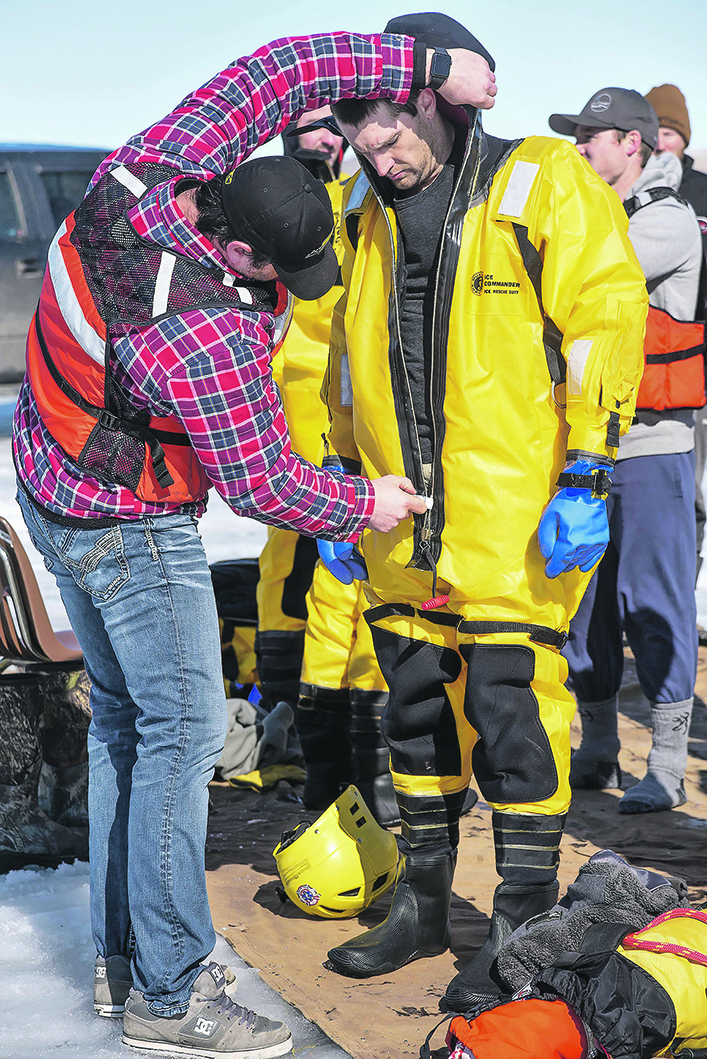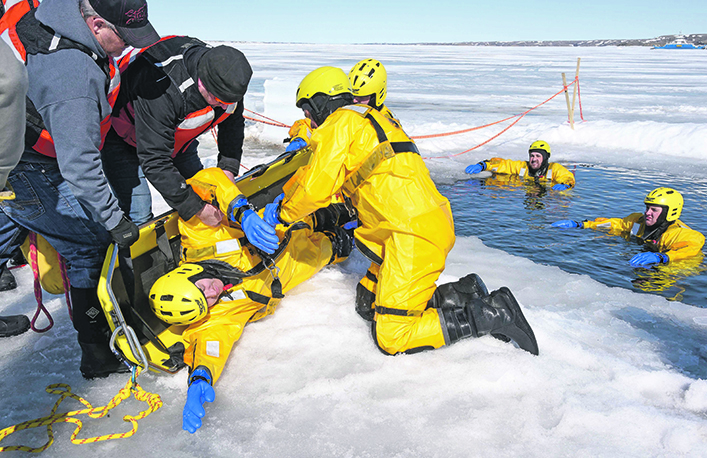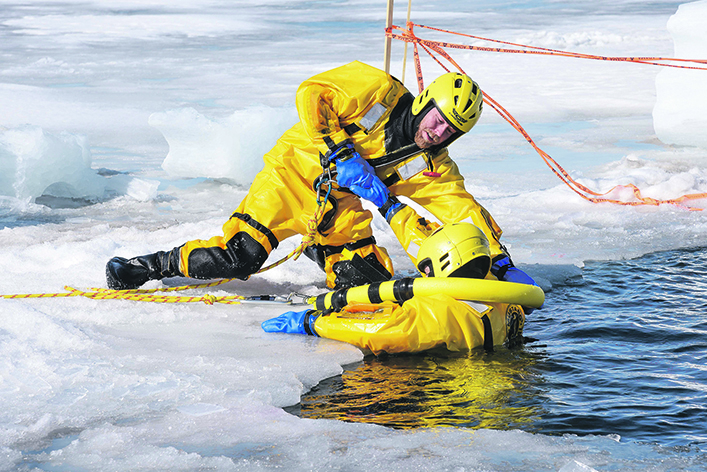Volunteer firefighters from Sask. communities near Lake Diefenbaker learn how to respond to accidents on the ice
The risk of accidents befalling people in water and ice may rise as traffic on Lake Diefenbaker increases, according to local fire department officials.
From boating and swimming to ice fishing and waterskiing, the manmade lake is a popular recreational destination.
Two volunteer fire departments near the lake’s east side recently undertook rescue training in case accidents happen. Twelve members from the Riverhurst Fire Department and Central Butte Fire and Rescue took part in an open water and ice course.
“We’re a small group, mostly farmers focused mainly on grass fires. But in the last few years, especially with COVID, we’ve noticed that the traffic on Lake Diefenbaker has gone through the roof and that’s right on our doorstep, one kilometre away from the fire station,” said Bo Langer of Riverhurst, who helped organize the training event.
“There’s usually a couple trucks that go through each year in ice-fishing season. Last summer we got our first water rescue call with a fatality and realized this is something we really need to get involved in. 911 receives about 10 calls per year for Lake Diefenbaker.
“We’re trying to get ahead of it before the calls happen, to be trained and equipped as much as we can,” he said.

Central Butte Fire and Rescue is further from the lake but it still handles farm-related emergencies involving dugouts, lagoons and sloughs.
“Every year there’s always a dad out on a dugout or slough with a Bobcat clearing snow for his kids to go skating and the Bobcat goes through. And we hear stories of the kids falling in and there’s no one to help rescue,” said Myron Fowler, fire chief of Central Butte Fire and Rescue.
“This training is going to go a long way to hopefully providing some rescue abilities for that.”
Thanks to a $20,000 grant from Richardson Pioneer and the Richardson Foundation, the two volunteer departments hired Bill McCombs of Trans-Care Rescue in Langham, Sask., to teach the Surface Ice Rescue Technician course. McCombs is also the fire chief for the Langham Fire Department.

The 16-hour program gives information on the command system for ice accidents, how ice is formed, cold water drowning/hypothermia, ice rescue equipment and techniques.
Students learn how to safely perform ice rescue by understanding ice conditions and determining ice strength, as well as self-rescue, shore-based rescue, rescue using platforms and entry rescue. They also learn how to recognize and treat hypothermia and how to safely move a casualty.
In addition to the two days of training, funding covered the purchase of flotation boards used in ice rescues, several cold-water dry suits, throw bags, ropes and personal flotation devices.

While some parts of the yellow suits fit tightly, Langer said he was surprised at how easy it is to move around, which increased his confidence.
“They give us full flotation and we don’t get wet at all. They’re completely sealed, so you can jump in the water and not have to worry about being cold in -40 C conditions,” he said.
A few days before the training, firefighters used saws and augers to cut and remove several large ice blocks to create a 12-foot hole in the lake.
McCombs said the giant ice cubes scattered around the open water hole show the instability of melting ice.
“This time of the year is the most dangerous because the temperature is very quickly rising. Even though the ice looks like it’s safe on the surface, it could be candling, where the ice has lost its structural integrity and is starting to separate. It might be safe right where you’re standing, but five feet away you’ll fall through,” he said.
Candling is a term used to describe the look of individual icicles stacked together like columns. As temperatures rise, their bonds lose strength.
Ice should be at least three or four inches thick to walk on safely. Six inches is the minimum for snowmobiles, eight to 12 inches for a light car and 12 to 15 inches for a regular pickup truck.
“I like to see a lot more, personally,” he said.

However, guidelines for what constitutes safe ice have changed over time.
“The ice conditions are deteriorating from what they used to be. Water quality 50 years ago is not the same at all to now. That’s got to do with organic stuff in the air and water. We get more and more contaminants in there all the time from agricultural runoff,” he said.
The end of ice fishing season is customarily marked by the breakup of ice. Besides freeze-up in late fall, spring is the most dangerous time to be on ice because it is unpredictable and constantly changing.
“There’s always those guys that push it right to the bitter end and they’ve got to be out on the ice. There’s been piles of vehicles go through. Ice fishermen are some of the luckiest people in the entire world. Not the smartest, necessarily, but they are the luckiest,” McComb said.

He warns people not to venture out on ice now, but also has tips for those who do.
“Number one is, make sure that somebody knows where you are and you shouldn’t be alone. If you’ve got to go out on the ice for some reason like work, then have ice picks and be wearing proper flotation gear,” he said.
Follow the 1-10-1 rule in an emergency.
“You’ve got one minute when you fall through to get your breathing under control or you’ll drown. Then you’ve got 10 minutes to get out. If you can’t get out at 10 minutes, then the concept is to try to get up high enough that you can hang on to the ice. After that you’ve got approximately an hour of survival time.”
















